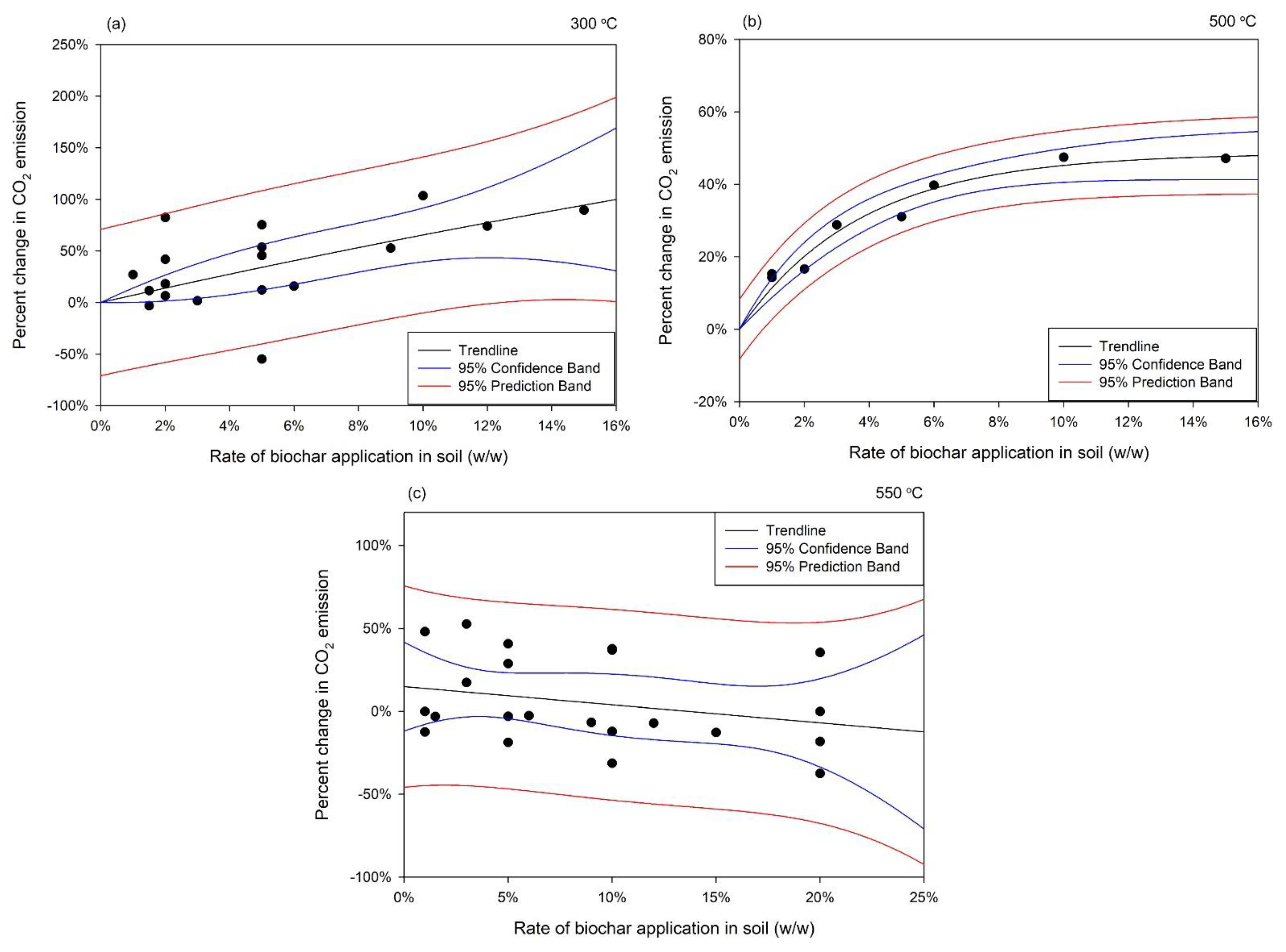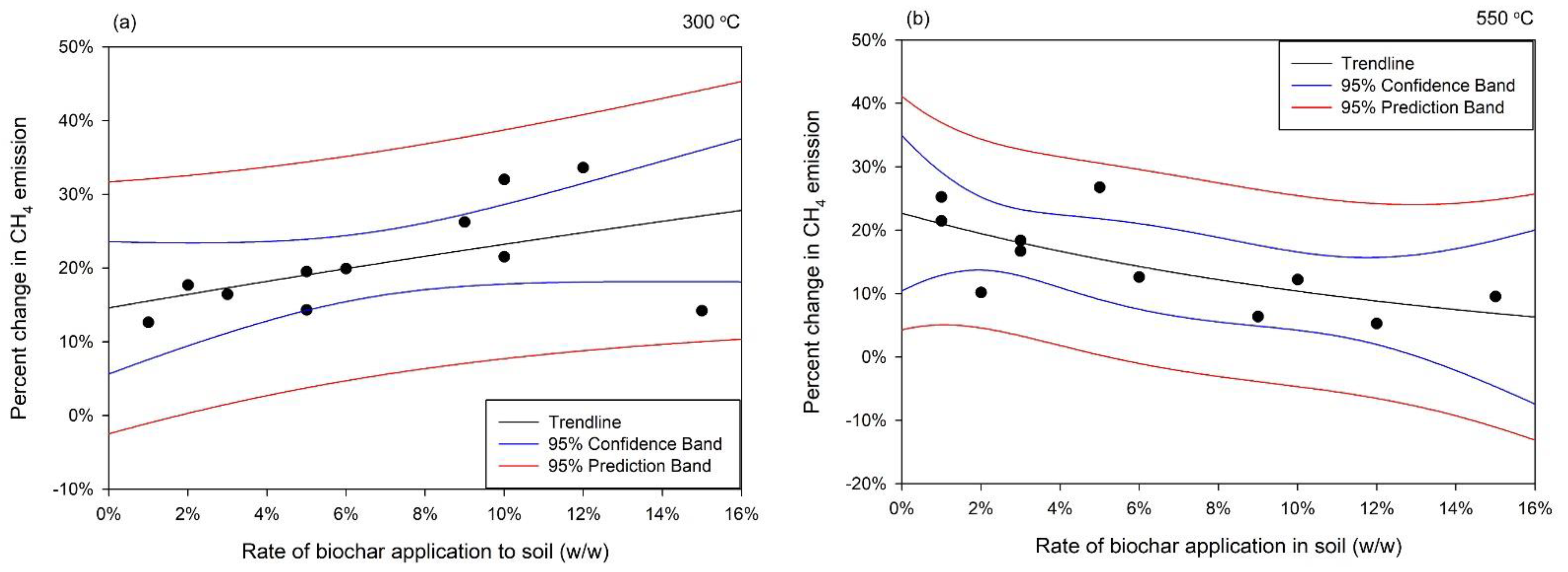Will Biochar Suppress or Stimulate Greenhouse Gas Emissions in Agricultural Fields? Unveiling the Dice Game through Data Syntheses
Abstract
1. Introduction
2. Methodologies
2.1. Screening Published Articles as Data Sources
2.2. Collecting Quantitative Data
2.3. Processing Data from Different Articles
2.4. Statistical Analyses
3. Results
3.1. Effects of Biochar on CO2 Emissions
3.2. Effects of Biochar on CH4 Emissions
3.3. Effects of Biochar on N2O Emissions
4. Discussion
4.1. Influences of Pyrolysis Temperature and Application Rate of Biochar on CO2 Emissions
4.2. Influences of Pyrolysis Temperature and Application Rate of Biochar on CH4 Emissions
4.3. Influences of Pyrolysis Temperature and Application Rate of Biochar on N2O Emissions
4.4. Effects of the Same Biochar on the Emissions of Different GHGs
4.5. Effects of Different Biochars on the Emissions of the Same GHG
4.6. Future Research Directions
Author Contributions
Funding
Institutional Review Board Statement
Informed Consent Statement
Data Availability Statement
Conflicts of Interest
References
- Astrom, D.O.; Forsberg, B.; Ebi, K.L.; Rocklov, J. Attributing Mortality from Extreme Temperatures to Climate Change in Stockholm, Sweden. Nat. Clim. Chang. 2013, 3, 1050–1054. [Google Scholar] [CrossRef]
- Stott, P. How Climate Change Affects Extreme Weather Events. Science 2016, 352, 1517–1518. [Google Scholar] [CrossRef] [PubMed]
- van Koningsveld, M.; Mulder, J.P.M.; Stive, M.J.F.; van der Valk, L.; van der Weck, A.W. Living with Sea-Level Rise and Climate Change: A Case Study of the Netherlands. J. Coast. Res. 2008, 242, 367–379. [Google Scholar] [CrossRef]
- Chiabai, A.; Quiroga, S.; Martinez-Juarez, P.; Higgins, S.; Taylor, T. The Nexus between Climate Change, Ecosystem Services and Human Health: Towards a Conceptual Framework. Sci. Total Environ. 2018, 635, 1191–1204. [Google Scholar] [CrossRef]
- Tol, R.S.J. The Economic Impacts of Climate Change. Rev. Environ. Econ. Policy 2018, 12, 4–25. [Google Scholar] [CrossRef]
- Campbell, B.; Hansen, J.; Rioux, J.; Stirling, C.M.; Twomlow, S.; Wollenberg, E. Urgent Action to Combat Climate Change and Its Impacts (SDG 13): Transforming Agriculture and Food Systems. Curr. Opin. Environ. Sustain. 2018, 34, 13–20. [Google Scholar] [CrossRef]
- Turney, C.; Ausseil, A.G.; Broadhurst, L. Urgent Need for an Integrated Policy Framework for Biodiversity Loss and Climate Change. Nat. Ecol. Evol. 2020, 4, 996. [Google Scholar] [CrossRef]
- Montzka, S.A.; Dlugokencky, E.J.; Butler, J.H. Non-CO2 Greenhouse Gases and Climate Change. Nature 2011, 476, 43–50. [Google Scholar] [CrossRef]
- USEPA. Sources of Greenhouse Gas Emissions. Available online: https://www.epa.gov/ghgemissions/ (accessed on 5 August 2022).
- Li, S.; Chen, G. Contemporary Strategies for Enhancing Nitrogen Retention and Mitigating Nitrous Oxide Emission in Agricultural Soils: Present and Future. Environ. Dev. Sustain. 2019, 22, 2703–2741. [Google Scholar] [CrossRef]
- Oni, B.A.; Oziegbe, O.; Olawole, O.O. Significance of Biochar Application to the Environment and Economy. Ann. Agric. Sci. 2019, 64, 222–236. [Google Scholar] [CrossRef]
- Li, S.; Chen, G. Thermogravimetric, Thermochemical, and Infrared Spectral Characterization of Feedstocks and Biochar Derived at Different Pyrolysis Temperatures. Waste Manag. 2018, 78, 198–207. [Google Scholar] [CrossRef] [PubMed]
- Li, S.; Barreto, V.; Li, R.W.; Chen, G.; Hsieh, Y.P. Nitrogen Retention of Biochar Derived from Different Feedstocks at Variable Pyrolysis Temperatures. J. Anal. Appl. Pyrolysis 2018, 133, 136–146. [Google Scholar] [CrossRef]
- Gezahegn, S.; Sain, M.; Thomas, S.C. Variation in Feedstock Wood Chemistry Strongly Influences Biochar Liming Potential. Soil Syst. 2019, 3, 26. [Google Scholar] [CrossRef]
- Zhang, Y.; Wang, J.; Feng, Y. The Effects of Biochar Addition on Soil Physicochemical Properties: A Review. CATENA 2021, 202, 105284. [Google Scholar] [CrossRef]
- Rogovska, N.; Laird, D.; Cruse, R.; Fleming, P.; Parkin, T.; Meek, D. Impact of Biochar on Manure Carbon Stabilization and Greenhouse Gas Emissions. Soil Biol. Biochem. 2011, 75, 871–879. [Google Scholar] [CrossRef]
- Fidel, R.B.; Laird, D.; Parkin, T. Effect of Biochar on Soil Greenhouse Gas Emissions at the Laboratory and Field Scales. Soil Syst. 2019, 3, 8. [Google Scholar] [CrossRef]
- Wang, J.; Pan, X.; Liu, Y.; Zhang, X.; Xiong, Z. Effects of Biochar Amendment in Two Soils on Greenhouse Gas Emissions and Crop Production. Plant Soil 2012, 360, 287–298. [Google Scholar] [CrossRef]
- Mandal, S.; Sarkar, B.; Bolan, N.; Novak, J.; Ok, Y.S.; van Zwieten, L.; Singh, B.P.; Kirkham, M.B.; Choppala, G.; Spokas, K.; et al. Designing Advanced Biochar Products for Maximizing Greenhouse Gas Mitigation Potential. Crit. Rev. Environ. Sci. Technol. 2016, 46, 1367–1401. [Google Scholar] [CrossRef]
- Case, S.D.C.; McNamara, N.P.; Reay, D.S.; Stott, A.W.; Grant, H.K.; Whitaker, J. Biochar Suppresses N2O Emissions While Maintaining N Availability in a Sandy Loam Soil. Soil Biol. Biochem. 2015, 81, 178–185. [Google Scholar]
- Deng, W.; van Zwieten, L.; Lin, Z.; Liu, X.; Sarmah, A.K.; Wang, H. Sugarcane Bagasse Biochars Impact Respiration and Greenhouse Gas Emissions from a Latosol. J. Soils Sediments 2016, 17, 632–640. [Google Scholar] [CrossRef]
- Yoo, G.; Kang, H. Effects of Biochar Addition on Greenhouse Gas Emissions and Microbial Responses in a Short-Term Laboratory Experiment. J. Environ. Qual. 2012, 41, 1193–1202. [Google Scholar] [CrossRef] [PubMed]
- Guo, F.; Zhang, J.; Yang, X.; He, Q.; Ao, L.; Chen, Y. Impact of Biochar on Greenhouse Gas Emissions from Constructed Wetlands under Various Influent Chemical Oxygen Demand to Nitrogen Ratios. Bioresour. Technol. 2020, 303, 122908. [Google Scholar] [CrossRef] [PubMed]
- Zheng, N.; Yu, Y.; Li, Y.; Ge, C.; Chapman, S.J.; Yao, H. Can Aged Biochar Offset Soil Greenhouse Gas Emissions from Crop Residue Amendments in Saline and Non-Saline Soils under Laboratory Conditions? Sci. Total Environ. 2022, 806, 151256. [Google Scholar] [CrossRef] [PubMed]
- Verhoeven, E.; Six, J. Biochar Does Not Mitigate Field-Scale N2O Emissions in a Northern California Vineyard: An Assessment across Two Years. Agric. Ecosyst. Environ. 2014, 191, 27–38. [Google Scholar] [CrossRef]
- Schimmelpfennig, S.; Muller, C.; Grunhage, L.; Koch, C.; Kammann, C. Biochar, Hydrochar and Uncarbonized Feedstock Application to Permanent Grassland—Effects on Greenhouse Gas Emissions and Plant Growth. Agric. Ecosyst. Environ. 2014, 191, 39–52. [Google Scholar] [CrossRef]
- Brickler, C.A.; Wu, Y.; Li, S.; Anandhi, A.; Chen, G. Comparing Physicochemical Properties and Sorption Behaviors of Pyrolysis-Derived and Microwave-Mediated Biochar. Sustainability 2021, 13, 2359. [Google Scholar] [CrossRef]
- Wu, Y.; Brickler, C.A.; Li, S.; Chen, G. Synthesis of Microwave-Mediated Biochar-Hydrogel Composites for Enhanced Water Absorbency and Nitrogen Release. Polym. Test. 2021, 93, 106996. [Google Scholar] [CrossRef]
- Cayuela, M.L.; Jeffery, S.; van Zwieten, L. The Molar H:Corg Ratio of Biochar Is a Key Factor in Mitigating N2O Emissions from Soil. Agric. Ecosyst. Environ. 2015, 202, 135–138. [Google Scholar] [CrossRef]
- Li, S.; Harris, S.; Anandhi, A.; Chen, G. Predicting Biochar Properties and Functions Based on Feedstock and Pyrolysis Temperature: A Review and Data Syntheses. J. Clean. Prod. 2019, 215, 890–902. [Google Scholar] [CrossRef]
- Luo, Y.; Yu, Z.; Zhang, K.; Xu, J.; Brookes, P.C. The Properties and Functions of Biochars in Forest Ecosystems. J. Soils Sediments 2016, 16, 2005–2020. [Google Scholar] [CrossRef]
- Ajayi, A.E.; Holthusen, D.; Horn, R. Changes in Microstructural Behaviour and Hydraulic Functions of Biochar Amended Soils. Soil Tillage Res. 2016, 155, 166–175. [Google Scholar] [CrossRef]
- Menke, J.; Roelandse, M.; Ozyurt, B.; Martone, M.; Bandrowski, A. The Rigor and Transparency Index Quality Metric for Assessing Biologicla and Medical Science Methods. iScience 2020, 23, 101698. [Google Scholar] [CrossRef] [PubMed]
- Opthof, T. Sense and Nonsense about the Impact Factor. Cardiovasc. Res. 1997, 31, 1–7. [Google Scholar] [CrossRef]
- Simons, K. The Misused Impact Factor. Science 2008, 322, 165. [Google Scholar] [CrossRef]
- Mangalassery, S.; Sjogersten, S.; Sparkes, D.L.; Sturrock, C.J.; Craigon, J.; Mooney, S.J. To What Extent Can Zero Tillage Lead to a Reduction in Greenhouse Gas Emissions from Temperate Soils? Sci. Rep. 2014, 4, 4586. [Google Scholar] [CrossRef]
- Smith, P. Soil Carbon Sequestration and Biochar as Negative Emission Technologies. Glob. Chang. Biol. 2016, 22, 1315–1324. [Google Scholar] [CrossRef]
- Pereira, R.C.; Kaal, J.; Camps Arbestain, M.; Pardo Lorenzo, R.; Aitkenhead, W.; Hedley, M.; Macia, F.; Hindmarsh, J.; Macia-Agullo, J.A. Contribution to Characterisation of Biochar to Estimate the Labile Fraction of Carbon. Org. Geochem. 2011, 42, 1331–1342. [Google Scholar] [CrossRef]
- Mukome, F.N.D.; Six, J.; Parikh, S.J. The Effects of Walnut Shell and Wood Feedstock Biochar Amendments on Greenhouse Gas Emissions from a Fertile Soil. Geoderma 2013, 200–201, 90–98. [Google Scholar] [CrossRef]
- Ohde, S.; Woesik, V. Carbon Dioxide Flux and Metabolic Processes of a Coral Reef, Okinawa. Bull. Mar. Sci. 1999, 65, 559–576. [Google Scholar]
- Girkin, N.T.; Dhandapani, S.; Evers, S.; Ostle, N.; Turner, B.L.; Sjogersten, S. Interactions between Labile Carbon, Temperature and Land Use Regulate Carbon Dioxide and Methane Production in Tropical Peat. Biogeochemistry 2020, 147, 87–97. [Google Scholar] [CrossRef]
- Miransari, M. Soil Microbes and the Availability of Soil Nutrients. Acta Physiol. Plant. 2013, 35, 3075–3084. [Google Scholar] [CrossRef]
- Manzoni, S.; Schimel, J.P.; Porporato, A. Responses of Soil Microbial Communities to Water Stress: Results from a Meta-Analysis. Ecology 2012, 93, 930–938. [Google Scholar] [CrossRef] [PubMed]
- Leng, L.; Xiong, Q.; Yang, L.; Li, H.; Zhou, Y.; Zhang, W.; Jiang, S.; Li, H.; Huang, H. An Overview on Engineering the Surface Area and Porosity of Biochar. Sci. Total Environ. 2021, 763, 144204. [Google Scholar] [CrossRef]
- Amoakwah, E.; Frimpong, K.A.; Okae-Anti, D.; Arthur, E. Soil Water Retention, Air Flow and Pore Structure Characteristics after Corn Cob Biochar Application to a Tropical Sandy Loam. Geoderma 2017, 307, 189–197. [Google Scholar] [CrossRef]
- Garg, A.; Huang, H.; Kushvaha, V.; Madhushri, P.; Kamchoom, V.; Wani, I.; Koshy, N.; Zhu, H.H. Mechanism of Biochar Soil Pore–Gas–Water Interaction: Gas Properties of Biochar-Amended Sandy Soil at Different Degrees of Compaction using KNN Modeling. Acta Geophys. 2020, 68, 207–217. [Google Scholar] [CrossRef]
- Ameloot, N.; Graber, E.R.; Verheijen, F.G.A.; De Neve, S. Interactions between Biochar Stability and Soil Organisms: Review and Research Needs. Eur. J. Soil Sci. 2013, 64, 379–390. [Google Scholar] [CrossRef]
- Jaafar, N.M.; Clode, P.L.; Abbott, L.K. Soil Microbial Responses to Biochars, Varying in Particle Size, Surface and Pore Properties. Pedosphere 2015, 25, 770–780. [Google Scholar] [CrossRef]
- Bamminger, C.; Poll, C.; Sixt, C.; Hogy, P.; Wust, D.; Kandeler, E.; Marhan, S. Short-Term Response of Soil Microorganisms to Biochar Addition in a Temperate Agroecosystem under Soil Warming. Agric. Ecosyst. Environ. 2016, 233, 308–317. [Google Scholar] [CrossRef]
- Sinsabaugh, R.L.; Hill, B.H.; Follstad Shah, J.J. Ecoenzymatic Stoichiometry of Microbial Organic Nutrient Acquisition in Soil and Sediment. Nature 2009, 462, 795–798. [Google Scholar] [CrossRef]
- Zornoza, R.; Moreno-Barriga, E.; Acosta, J.A.; Munoz, M.A.; Faz, A. Stability, Nutrient Availability and Hydrophobicity of Biochars Derived from Manure, Crop Residues, and Municipal Solid Waste for Their Use as Soil Amendments. Chemosphere 2016, 144, 122–130. [Google Scholar] [CrossRef]
- Zhu-Barker, X.; Burger, M.; Horwath, W.R.; Green, P.G. Direct Green Waste Land Application: How to Reduce Its Impacts on Greenhouse Gas and Volatile Organic Compound Emissions? Waste Manag. 2016, 52, 318–325. [Google Scholar] [CrossRef] [PubMed]
- Cayuela, M.L.; Sanchez-Garcia, M.; Roig, A.; Hanley, K.; Enders, A.; Lehmann, J. Biochar and Denitrification in Soils: When, How Much and Why Does Biochar Reduce N2O Emissions? Sci. Rep. 2013, 3, 1732. [Google Scholar] [CrossRef] [PubMed]
- Liu, Y.; Tang, H.; Muhammad, A.; Huang, G. Emission Mechanism and Reduction Countermeasures of Agricultural Greenhouse Gases—A Review. Greenh. Gases Sci. Technol. 2019, 9, 160–174. [Google Scholar] [CrossRef]



Publisher’s Note: MDPI stays neutral with regard to jurisdictional claims in published maps and institutional affiliations. |
© 2022 by the authors. Licensee MDPI, Basel, Switzerland. This article is an open access article distributed under the terms and conditions of the Creative Commons Attribution (CC BY) license (https://creativecommons.org/licenses/by/4.0/).
Share and Cite
Li, S.; Chan, C.Y. Will Biochar Suppress or Stimulate Greenhouse Gas Emissions in Agricultural Fields? Unveiling the Dice Game through Data Syntheses. Soil Syst. 2022, 6, 73. https://doi.org/10.3390/soilsystems6040073
Li S, Chan CY. Will Biochar Suppress or Stimulate Greenhouse Gas Emissions in Agricultural Fields? Unveiling the Dice Game through Data Syntheses. Soil Systems. 2022; 6(4):73. https://doi.org/10.3390/soilsystems6040073
Chicago/Turabian StyleLi, Simeng, and Celeste Y. Chan. 2022. "Will Biochar Suppress or Stimulate Greenhouse Gas Emissions in Agricultural Fields? Unveiling the Dice Game through Data Syntheses" Soil Systems 6, no. 4: 73. https://doi.org/10.3390/soilsystems6040073
APA StyleLi, S., & Chan, C. Y. (2022). Will Biochar Suppress or Stimulate Greenhouse Gas Emissions in Agricultural Fields? Unveiling the Dice Game through Data Syntheses. Soil Systems, 6(4), 73. https://doi.org/10.3390/soilsystems6040073






